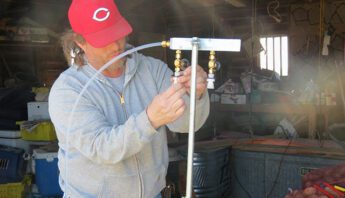Contact:
Heather Pilatic, Communications Director
Pesticide Action Network North America
cell: 415.694.8596
heather@panna.org
Experts Convene to Consider Hazards of Pesticide Drift
Air monitoring documents invisible route of chemical exposure, EPA to evaluate
Arlington, VA (December 1-3, 2009) – After years of denying that people who live in agricultural areas are exposed to pesticides in the air, the Environmental Protection Agency is convening experts this week to examine the dangers of pesticides that drift off of farms for days after the chemicals are applied.
“We are encouraged that EPA’s Scientific Advisory Panel is finally beginning to evaluate the impacts of volatilization drift on agricultural communities,” says Dr. Susan Kegley, consulting scientist for Pesticide Action Network North America (PANNA).
Volatization drift occurs when pesticides vaporize and drift to adjacent areas for days or even weeks after pesticide applications. Volatization drift is distinct from spray drift, which occurs when pesticides drift off target during application. “U.S. EPA should take the lead in creating the necessary scientific tools to protect residents of agricultural areas,” continues Kegley. “In the meantime, affected communities are desperate for immediate relief from these toxic exposures. EPA should take protective action as soon as possible, even while the scientific details are being reviewed.”
PANNA has used its Drift Catcher device for the last five years to work with communities to document volatilization drift and make the case to regulators that the illnesses and damage caused by drift can no longer be ignored. Air monitoring data collected by community members near their homes and schools with the Drift Catcher indicate that communities are being exposed to drift from volatilized pesticides, on many occasions receiving doses above levels considered “safe” by EPA. These exposures can affect communities in both subtle and more obvious ways. Human illness, bird kills, domestic animal deaths, damage to gardens and landscaping, and water contamination were all reported by community members as part of their experience with pesticide drift.
"In addition to the health problems associated with exposure to these toxic chemicals, there can be economic damages to farms when these pesticides deposit on organically grown crops making them illegal for sale on the organic market," says Larry Jacobs, who co-founded Jacobs Farm and Del Cabo Cooperative with the goal of producing food in an environmentally and socially responsible manner. “Because of volatilization of organophosphate, I experienced significant economic loss in my 2006 and 2007 harvests of rosemary, sage, and dill.” A jury subsequently awarded Jacobs a $1 million verdict as compensation for his losses, although the case is currently under appeal.
Volatilization drift is currently unregulated by US EPA (with the exception of new rules for fumigant pesticides), yet is a major contributor to exposure for communities near areas of high use of these pesticides. Agricultural communities and farm workers face toxic exposures from airborne pesticide drift from the numerous pesticide applications that routinely occur close to homes, schools and workplaces. Environmental and pesticide reform advocates have long been concerned about these exposures and are encouraged by the EPA convening this groundbreaking session to examine these issues. They are hopeful that this will set EPA on track to regulate volatilization drift and its impacts on agricultural workers and residents of agricultural communities.
###
Following are additional statements by environmental and farmworker health advocates in response to the Scientific Advisory Panel’s meetings this week:
Some of the most toxic pesticides, such as the insecticides chlorpyrifos and diazinon, have been banned for use in residential areas, yet continue to be used in agriculture. Carol Dansereau, Executive Director of Farm Worker Pesticide Project in Washington State says, “Chlorpyrifos is associated with serious health problems, yet agricultural workers and their families continue to be exposed to this chemical. EPA should act immediately to end this environmental injustice. State and federal agencies charged with enforcing pesticide laws should defend people’s rights to be free from contacts with chlorpyrifos.”
Lisa Arkin, Executive Director of Oregon Toxics Alliance, says, “Our organization continually hears from individuals who reside in rural areas near forestry and agricultural operations, or are exposed to pesticides through routine state agency operations. Many of these individuals are severely impacted by these exposures that can limit their ability to go outdoors and to feel safe on their own property. For instance, some individuals find it impossible to travel our state highways after they have been sprayed with herbicides because of the volatilization of these chemicals. EPA should broaden their examination of volatilization drift to include these residential exposures.”
Available for Interviews:
Susan Kegley, PhD, Consulting Scientist with Pesticide Action Network North America and CEO of Pesticide Research Institute,
skegley@pesticideresearch.com, (510) 759-9397
Dr. Kegley has been working for many years on this issue; she helped invent a drift catching device to record chemical exposure, and can discuss studies that demonstrate health effects.
Jennifer Sass, PhD, Senior Scientist with Natural Resources Defense Council,
jsass@nrdc.org, (202) 289-6868
Dr. Sass works on issues related to health and the environment and promotes the use of safer alternatives to toxic agricultural chemicals.
Carol Dansereau, Executive Director, Farm Worker Pesticide Project,
cdansereauFWPP@earthlink.net, (206) 729-0498
Carol has worked for many years to reduce and eliminate the exposure of farmworker communities to pesticides, and to research and compile exposure data. She is able to discuss these studies and their policy implications.
Larry Jacobs, President, Jacobs Farm/Del Cabo Cooperative,
Larry@delcabo.com, (650) 224-0805
Larry can discuss his experience with pesticide volatilization and its impacts on his business, and his ongoing efforts to improve the lives of small-scale growers and their families by providing economic opportunities and a safer environment free of toxic and persistent chemicals.
Lisa Arkin, Executive Director, Oregon Toxics Alliance,
larking@oregontoxics.org, (541) 520-2695, (541) 465-8860
Lisa has been involved in grassroots outreach to communities and individuals experiencing pesticide exposures, and has been working in coalition with them to find solutions to those exposure problems.
Additional Resources:
The Science of Drift, http://www.panna.org/drift/science
Report, “Poisons on the Wind: Community Air Monitoring” (PDF): http://www.fwpp.org/media/?id=49
Washington state’s air monitoring results for chlorpyrifos and azinphos methyl, http://www.doh.wa.gov/ehp/Pest/driftresults.htm
Fact Sheet, “Pesticides in the Air – Kids at Risk” (PDF): www.earthjustice.org/library/factsheets/pesticides_kid_factsheet.pdf







